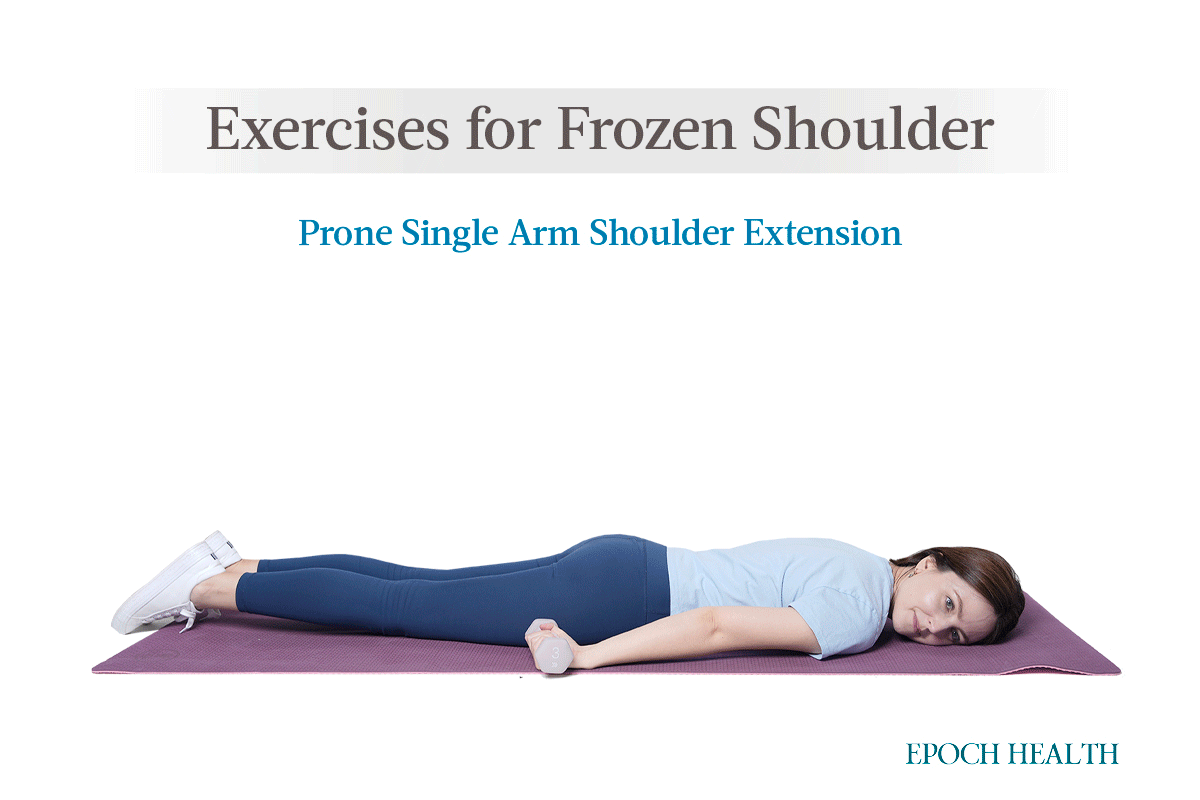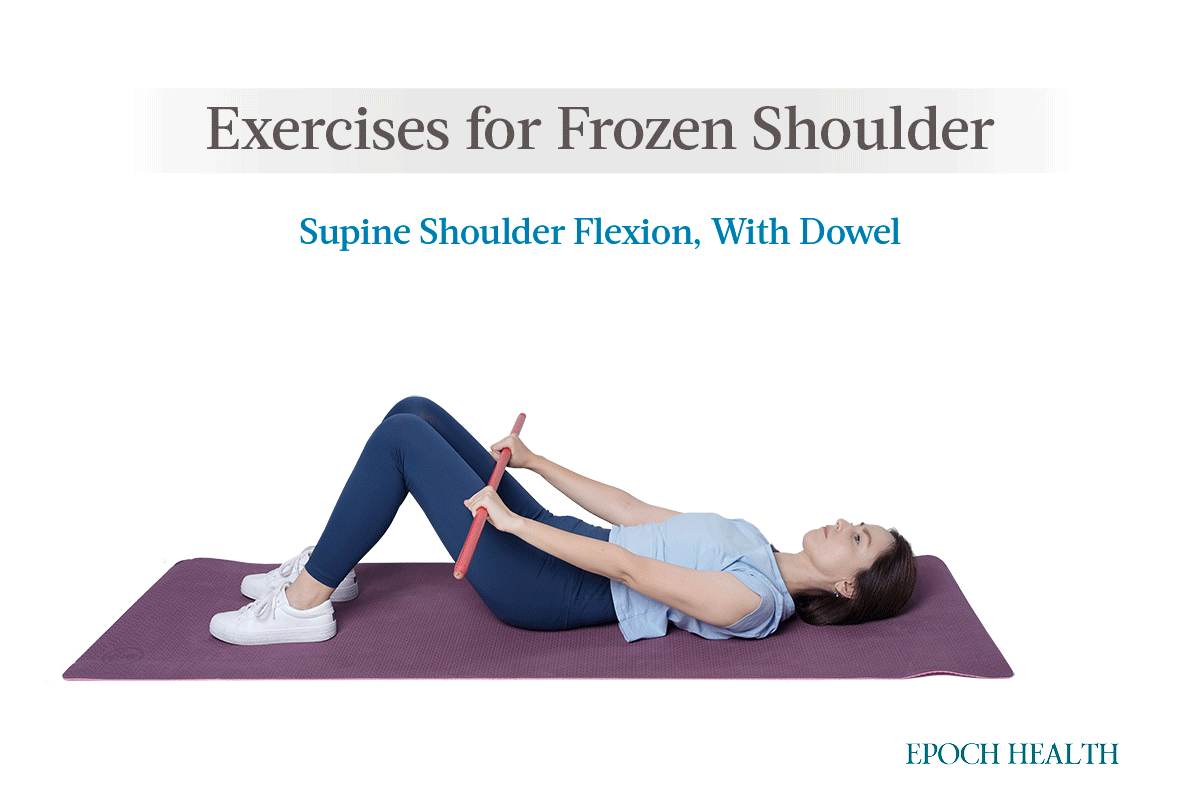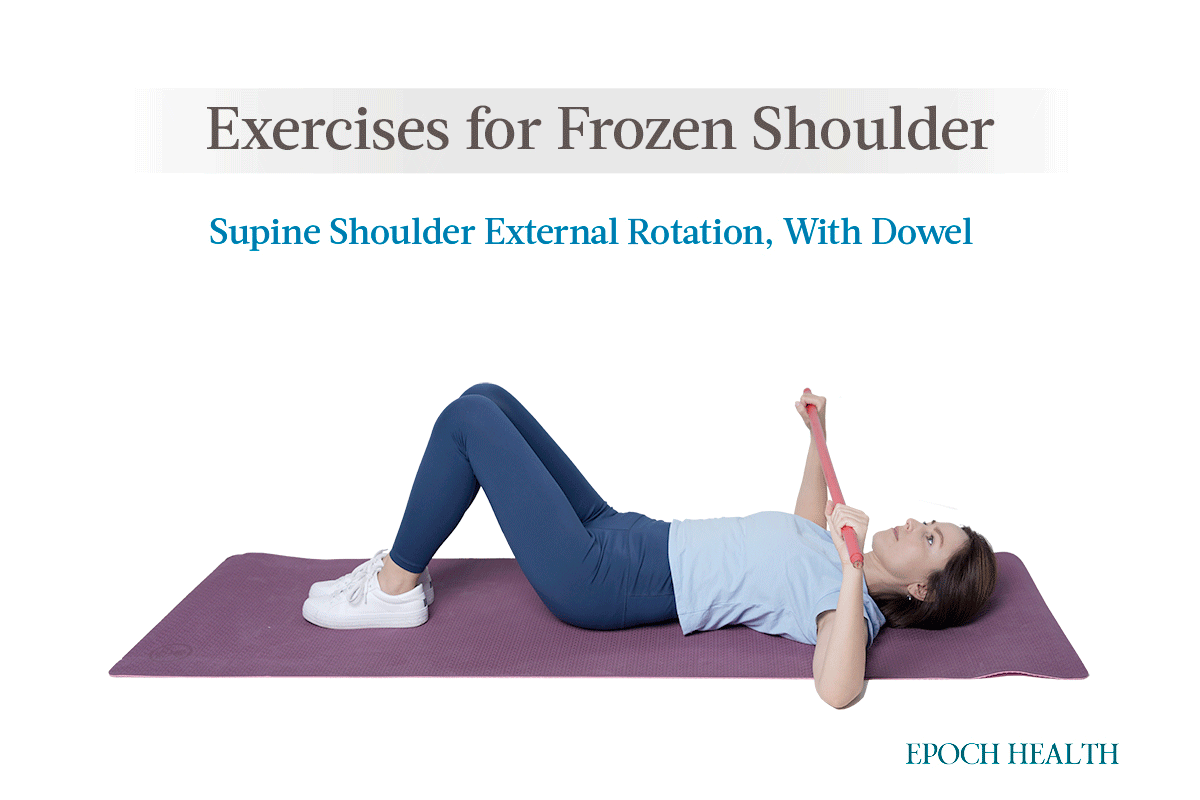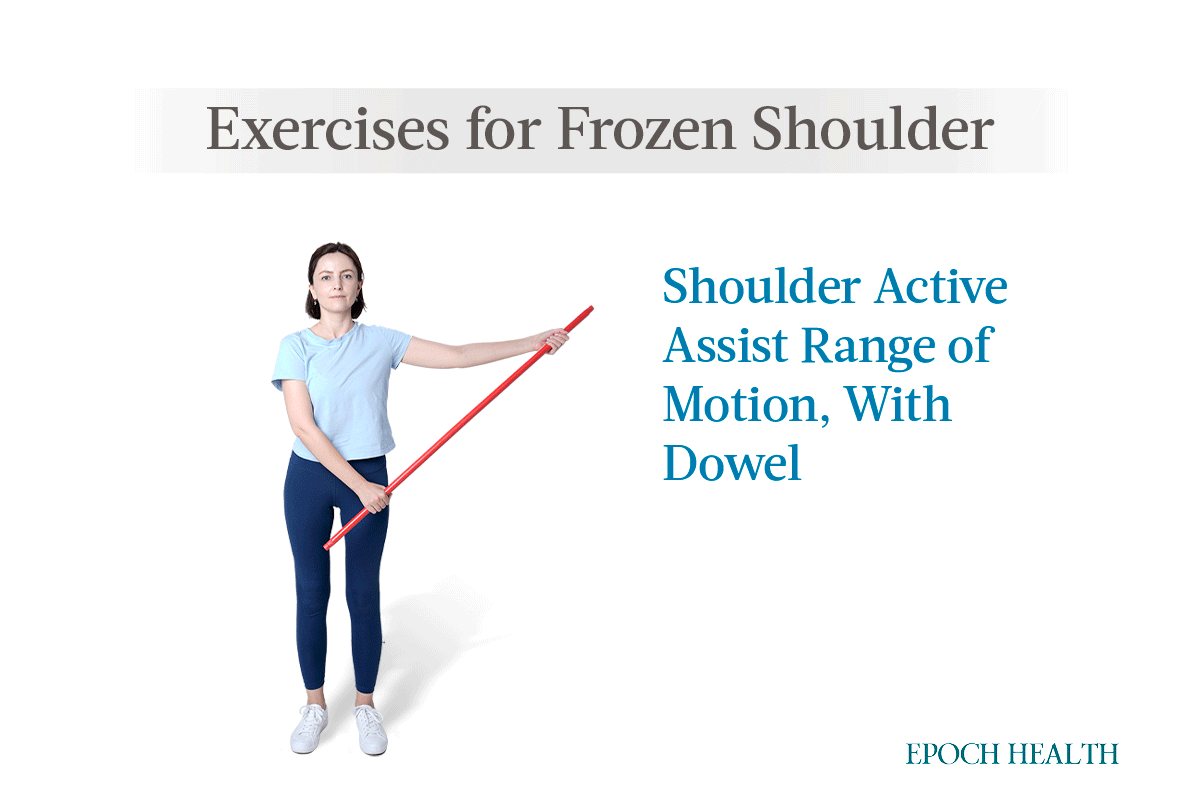By Kevin Shelley
As a therapist who frequently works on rehabilitating upper extremities, two of the most painful and frustrating presentations are fractured shoulders and frozen shoulders. These come with movement limitations that can take a patient weeks, months, or even years to recover, often resulting in residual restrictions in shoulder external rotation.
Frozen shoulder—also known as adhesive capsulitis—is an inflammatory condition that can start with a gradually progressive stiffness and lead to a significant restriction of range of motion. As capsulitis advances, shoulder flexion, external rotation, and abduction can all be severely affected.
Adhesive capsulitis most commonly appears in one shoulder and less commonly in both. It appears in women more than men and more often in the nondominant limb.
Rebecca Gold, an occupational therapist in Orlando, Florida, specializing in hand and upper body rehabilitation for over three decades, told The Epoch Times, “In earlier stages, it very clearly affects overhead movements, limiting the functional utilization of the arm.” Unfortunately, this often leads to the development of neck pathology as individuals commonly compensate for decreased shoulder range of motion by tapping into neck strategies.
Ms. Gold recommends that those who experience pain in the shoulder joint try to counter it by decreasing or altering utilization patterns of the affected limb.
The most effective treatment for frozen shoulder includes range-of-motion exercises.
6 Exercises to Prevent Frozen Shoulder
1. Prone Single-Arm Shoulder Extension
This exercise focuses on the back and shoulder muscles. It eliminates elbow movement and thus focuses all muscular exertion on the shoulder. This exercise can be performed one arm at a time or both arms at the same time.

- Step 1: Lie face down. For this exercise, you don’t need clearance for your arm to hang down.
- Step 2: Place your arm straight down by your side, holding a weight. Palms straight up is a great position, but you can experiment by positioning your hand such that your palm faces your side, with your thumb facing downward.
- Step 3: Being careful to keep your elbow straight, lift your hands straight up behind you and toward the ceiling while squeezing your shoulder blades together. Move slowly, taking approximately two seconds to move your arm as far back as possible. The overall movement will not be large.
- Step 4: Perform 10 repetitions per set and three total sets.
2. Supine Shoulder Flexion, With Dowel
The supine shoulder flexion exercise is excellent for moving your shoulder through a full range of motion in a controlled postural presentation.

Step 1: Lie on your back, allowing enough space to move your arms fully above your head.
- Step 2: Holding a dowel stick or any other straight stick long enough to allow your hands to rest shoulder-width apart (you can be creative), start with the stick resting on your hips.
- Step 3: Swing your arm through an arc while keeping your elbows straight until your hands touch the floor, or you move your shoulders as far as they can. Move slowly, taking up to four seconds to move through the arc.
- Step 4: Return slowly to the starting position and immediately begin the next repetition. Keep your elbows straight at all times.
- Step 5: Move through 10 repetitions per set and perform three sets.
3. Supine Shoulder External Rotation, With Dowel
“This exercise is excellent for targeting shoulder external rotation, which is one of the most problematic movements for individuals suffering from frozen shoulder,” Ms. Gold told The Epoch Times.

- Step 1: This exercise starts exactly like the supine shoulder flexion with dowel exercise, except that your elbows are bent to 90 degrees, your forearms and dowel move straight up, and your upper arms are fully out to your sides and touching the ground.
- Step 2: Keeping your elbows in place and your upper arms in contact with the ground, slowly bring the dowel over your head until your hands and dowel touch the ground just above your head. If you can’t go all the way back to the floor, go as far as you can. Take approximately three seconds to move through the full range of movement.
- Step 3: Move slowly back to the original starting position, taking about three seconds.
- Step 4: Moving your hands over your head and back counts as one repetition. Perform 10 repetitions per set and three total sets.
4. Shoulder Active Assist Range of Motion, With Dowel
Active overhead movements can be painful with capsulitis, but using a dowel stick can help you move your limb through the full range of motion.

- Step 1: Stand upright with your hands on a dowel stick approximately shoulder-width apart and your arms slightly forward and away from your body. Important: One hand should hold the dowel stick palm inward and face your body, while the other should face the palm outward. The arm with the palm facing outward will be the active limb moving overhead.
- Step 2: Keeping the elbow straight, move your painful limb through an arc so that your hand moves as high overhead as possible, using your other limb to help push the bar. Take approximately two to three seconds to complete the move up and another two to three seconds to move your limb back down into the starting position while carefully holding the elbow of the active limb straight through the entire movement.
- Step 3: Moving the limb all the way up and then back down counts as one repetition. Perform 10 total repetitions and complete three sets per side while alternating sides.
This exercise takes a little practice to master, but it is excellent for helping to maintain shoulder mobility.
5. Standing Sleeper Stretch
The sleeper stretch is a highly focused exercise for addressing shoulder internal rotation, a very critical functional movement component.
- Step 1: Start in a standing position with one shoulder against the wall. It helps to place your feet slightly away from the wall to lean into it. Bend your elbow to 90 degrees so your forearm is positioned horizontally across the front of your body with your palm down. Hold your wrist with your other hand.
- Step 2: Slowly lower your palm toward the ground, keeping your elbow in contact with the wall while using your other hand to guide the movement. Do not push into pain.
- Step 3: When you move your arm as far as you comfortably can, hold the position for three seconds before returning to the start position. Take two to three seconds to move your arm each way, paying careful attention to movement accuracy.
- Step 4: Moving your arm all the way down and back up is counted as one repetition. Perform 10 repetitions per set and three total sets.
6. Prone Shoulder Row
The prone shoulder row is great for strengthening the muscles on the back, helping restore upright posture, and moving away from the forward slumped posture that makes shoulder impingement more likely to happen.
- Step 1: Begin this exercise in a prone position from a table, bed, or other surface that allows your arm to hang down fully. Holding a hand weight will increase the intensity of this exercise.
- Step 2: Slowly pull the weight straight up while squeezing your shoulder blades together, moving your arm up as far as you comfortably can. Hold the position for one second before slowly lowering your arm straight back down. Take approximately two seconds to move both ways.
- Step 3: Perform 10 repetitions per set and three sets per side.
- Step 4: You can either complete all sets on one side before moving to the other side or alternate sides.
When performed at least once daily, these exercises can help maintain shoulder mobility and strength while enhancing posture, all of which can prevent or relieve adhesive capsulitis in your shoulder.
As a therapist who frequently works on rehabilitating upper extremities, two of the most painful and frustrating presentations are fractured shoulders and frozen shoulders. These come with movement limitations that can take a patient weeks, months, or even years to recover, often resulting in residual restrictions in shoulder external rotation.
Frozen shoulder—also known as adhesive capsulitis—is an inflammatory condition that can start with a gradually progressive stiffness and lead to a significant restriction of range of motion. As capsulitis advances, shoulder flexion, external rotation, and abduction can all be severely affected.
Adhesive capsulitis most commonly appears in one shoulder and less commonly in both. It appears in women more than men and more often in the nondominant limb.
Rebecca Gold, an occupational therapist in Orlando, Florida, specializing in hand and upper body rehabilitation for over three decades, told The Epoch Times, “In earlier stages, it very clearly affects overhead movements, limiting the functional utilization of the arm.” Unfortunately, this often leads to the development of neck pathology as individuals commonly compensate for decreased shoulder range of motion by tapping into neck strategies.
Ms. Gold recommends that those who experience pain in the shoulder joint try to counter it by decreasing or altering utilization patterns of the affected limb.
The most effective treatment for frozen shoulder includes range-of-motion exercises.
6 Exercises to Prevent Frozen Shoulder
1. Prone Single-Arm Shoulder Extension
This exercise focuses on the back and shoulder muscles. It eliminates elbow movement and thus focuses all muscular exertion on the shoulder. This exercise can be performed one arm at a time or both arms at the same time.

- Step 1: Lie face down. For this exercise, you don’t need clearance for your arm to hang down.
- Step 2: Place your arm straight down by your side, holding a weight. Palms straight up is a great position, but you can experiment by positioning your hand such that your palm faces your side, with your thumb facing downward.
- Step 3: Being careful to keep your elbow straight, lift your hands straight up behind you and toward the ceiling while squeezing your shoulder blades together. Move slowly, taking approximately two seconds to move your arm as far back as possible. The overall movement will not be large.
- Step 4: Perform 10 repetitions per set and three total sets.
2. Supine Shoulder Flexion, With Dowel
The supine shoulder flexion exercise is excellent for moving your shoulder through a full range of motion in a controlled postural presentation.

- Step 1: Lie on your back, allowing enough space to move your arms fully above your head.
- Step 2: Holding a dowel stick or any other straight stick long enough to allow your hands to rest shoulder-width apart (you can be creative), start with the stick resting on your hips.
- Step 3: Swing your arm through an arc while keeping your elbows straight until your hands touch the floor, or you move your shoulders as far as they can. Move slowly, taking up to four seconds to move through the arc.
- Step 4: Return slowly to the starting position and immediately begin the next repetition. Keep your elbows straight at all times.
- Step 5: Move through 10 repetitions per set and perform three sets.
3. Supine Shoulder External Rotation, With Dowel
“This exercise is excellent for targeting shoulder external rotation, which is one of the most problematic movements for individuals suffering from frozen shoulder,” Ms. Gold told The Epoch Times.

- Step 1: This exercise starts exactly like the supine shoulder flexion with dowel exercise, except that your elbows are bent to 90 degrees, your forearms and dowel move straight up, and your upper arms are fully out to your sides and touching the ground.
- Step 2: Keeping your elbows in place and your upper arms in contact with the ground, slowly bring the dowel over your head until your hands and dowel touch the ground just above your head. If you can’t go all the way back to the floor, go as far as you can. Take approximately three seconds to move through the full range of movement.
- Step 3: Move slowly back to the original starting position, taking about three seconds.
- Step 4: Moving your hands over your head and back counts as one repetition. Perform 10 repetitions per set and three total sets.
4. Shoulder Active Assist Range of Motion, With Dowel
Active overhead movements can be painful with capsulitis, but using a dowel stick can help you move your limb through the full range of motion.

- Step 1: Stand upright with your hands on a dowel stick approximately shoulder-width apart and your arms slightly forward and away from your body. Important: One hand should hold the dowel stick palm inward and face your body, while the other should face the palm outward. The arm with the palm facing outward will be the active limb moving overhead.
- Step 2: Keeping the elbow straight, move your painful limb through an arc so that your hand moves as high overhead as possible, using your other limb to help push the bar. Take approximately two to three seconds to complete the move up and another two to three seconds to move your limb back down into the starting position while carefully holding the elbow of the active limb straight through the entire movement.
- Step 3: Moving the limb all the way up and then back down counts as one repetition. Perform 10 total repetitions and complete three sets per side while alternating sides.
This exercise takes a little practice to master, but it is excellent for helping to maintain shoulder mobility.
5. Standing Sleeper Stretch
The sleeper stretch is a highly focused exercise for addressing shoulder internal rotation, a very critical functional movement component.
- Step 1: Start in a standing position with one shoulder against the wall. It helps to place your feet slightly away from the wall to lean into it. Bend your elbow to 90 degrees so your forearm is positioned horizontally across the front of your body with your palm down. Hold your wrist with your other hand.
- Step 2: Slowly lower your palm toward the ground, keeping your elbow in contact with the wall while using your other hand to guide the movement. Do not push into pain.
- Step 3: When you move your arm as far as you comfortably can, hold the position for three seconds before returning to the start position. Take two to three seconds to move your arm each way, paying careful attention to movement accuracy.
- Step 4: Moving your arm all the way down and back up is counted as one repetition. Perform 10 repetitions per set and three total sets.
6. Prone Shoulder Row
The prone shoulder row is great for strengthening the muscles on the back, helping restore upright posture, and moving away from the forward slumped posture that makes shoulder impingement more likely to happen.
- Step 1: Begin this exercise in a prone position from a table, bed, or other surface that allows your arm to hang down fully. Holding a hand weight will increase the intensity of this exercise.
- Step 2: Slowly pull the weight straight up while squeezing your shoulder blades together, moving your arm up as far as you comfortably can. Hold the position for one second before slowly lowering your arm straight back down. Take approximately two seconds to move both ways.
- Step 3: Perform 10 repetitions per set and three sets per side.
- Step 4: You can either complete all sets on one side before moving to the other side or alternate sides.
When performed at least once daily, these exercises can help maintain shoulder mobility and strength while enhancing posture, all of which can prevent or relieve adhesive capsulitis in your shoulder.






